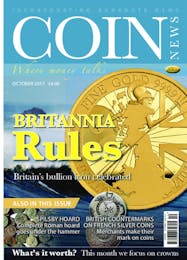Worth noting
THE big news in the past few weeks has, of course, been the launch of the new polymer £10 featuring writer Jane Austen (who was “waiting quietly in the wings” for her note debut, regardless of the feminist lobby who are STILL claiming credit for her appearance). The reason the new note has been so newsworthy isn’t because it is polymer (although the vegans are still up in arms about that one because the material contains tallow, an animal fat derivative) nor because it features Austen (the Royal Mint had already stolen the limelight there with the £2 coin) but rather, as with the Churchill note before it, because of what it might be worth. As with the £5 note the stories are all of notes being worth hundreds of times their face value, of people spotting rare serial numbers and cashing in—well good luck to them I say. If people are daft enough to pay £100s for an AK47 prefix note then that is up to them and as to the AA001 prefixes, well such publicity for our hobby can only be a good thing—the more people read about the prefixes and what is sought after and what is not, then the more they will understand us collectors and, hopefully, one or two might be encouraged to join our hobby too. In the coin world this sort of coverage has been happening for a while with various stories in the press concentrating on the rarity of various 50p and £1 coins, this has inevitably led to an increased in interest in checking one’s change and the ludicrous assertions that certain scarcer 50 pence pieces and £1 coins are fetching astronomical sums on eBay and the like. We frequently have to explain to over-excited callers that their “Offside rule” Olympics 50p may indeed be scarcer than a standard Britannia one but that doesn’t mean it is worth £400 and just because somebody has listed it as such on eBay doesn’t mean it will sell for that . . . and therein lies the problem.
Whilst it is true that there were fewer Jemima Puddleduck 50 pences minted than, for example, the Victoria Cross version (either one) and thus they are scarcer, that still doesn’t make them rare and because they aren’t actually rare they aren’t going to be worth a fortune. Even the Kew Gardens 50p, with a mintage of just 210,000 aren’t going to bring in a vast sum. True 210,000 is a miniscule number in modern minting terms, at least for a circulation coin, but the fact remains that there probably aren’t 210,000 people who want to own one, thus the price is never going to be stratospheric—especially not as the vast majority that appear for sale will have been taken from change and thus very circulated indeed. Banknotes on the other hand are slightly different—yes, of course, condition matters, hugely, and we all know by now that the slightest crease in a new polymer note really does stay there forever, but the notes have something that the coins don’t—serial numbers—and a very low number AA01 is always going to attract buyers, even if it has come from an ATM or been in a wallet because whilst there may be millions of similar notes out there, there will only ever be one AA01 000123 (or whatever). Unfortunately the newspapers and websites seem to be ignoring this difference and whilst they are, rightly, pointing to the interesting prefixes and low numbers (not so sure about the AK47s yet) on notes as being collectable, they are also getting all excited about the “rare” coins and are telling people that their pocket change can send them on a Caribbean cruise. This has, inevitably, got people scrabbling around in their purses, down the backs of sofas, et al, and has, whether numismatists like it or not, spawned a new generation of collectors—I just hope they won’t be too disillusioned when they find out that their “rarities” aren’t quite as valuable as they thought.
If you’re a new collector and are reading this please don’t be too disillusioned—some 50p pieces are worth some serious money (the “drowning swimmer” in particular) and, if you have a genuinely uncirculated Kew Gardens or a pristine Puddleduck you may well make more than 50p. Check out the brand new COIN YEARBOOK for details. If, however, you find that the tabloids had misled you into thinking you were sitting on a fortune, don’t despair, they are still fun things to collect and, at the end of the day they are still each worth a minimum of 50p—so if nothing else, collecting modern coins is a great way to save! Of course, if you’ve been collecting “round pounds” as a way of saving, don’t forget that this month sees the old coins demonetised—after October 15 you won’t be able to spend them in shops and whilst you may be able to pay them into your bank after that date, there is no obligation on the part of any bank to accept them—notes have the “I promise to pay the bearer on demand . . .” guarantee from the Bank of England, coins don’t—so cash up soon!

Archives
-
2024 (7 articles)
-
2023 (35 articles)
-
2022 (19 articles)
-
2021 (31 articles)
-
2020 (45 articles)
-
2019 (26 articles)
-
2018 (28 articles)
-
2017 (25 articles)
-
2016 (23 articles)
-
2015 (21 articles)
-
2014 (30 articles)
-
2013 (31 articles)
-
2012 (44 articles)
-
2011 (36 articles)
-
2010 (50 articles)
-
2009 (38 articles)
-
2008 (47 articles)
-
2007 (34 articles)
-
2006 (31 articles)
-
2005 (12 articles)
-
2004 (6 articles)
-
2003 (11 articles)
-
2002 (5 articles)
-
2001 (5 articles)









